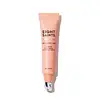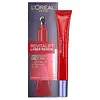What's inside
What's inside
 Key Ingredients
Key Ingredients

 Benefits
Benefits

 Concerns
Concerns

 Ingredients Side-by-side
Ingredients Side-by-side

Water
Skin ConditioningAloe Barbadensis Leaf Juice
Skin ConditioningHelianthus Annuus Seed Oil
EmollientIsopropyl Palmitate
EmollientCetyl Alcohol
EmollientGlyceryl Stearate Se
EmulsifyingGlycerin
HumectantStearic Acid
CleansingNiacinamide
SmoothingSodium Lactate
BufferingHyaluronic Acid
HumectantCamellia Sinensis Leaf Extract
AntimicrobialAvena Sativa Kernel Extract
AbrasiveCentella Asiatica Extract
CleansingEquisetum Arvense Extract
AstringentPelargonium Graveolens Extract
MaskingTaraxacum Officinale Extract
Skin ConditioningArnica Montana Flower
Skin ConditioningCalendula Officinalis Flower Extract
MaskingChamomilla Vulgaris Extract
Skin ProtectingLavandula Angustifolia Oil
MaskingCocos Nucifera Oil
MaskingSimmondsia Chinensis Seed Oil
EmollientRosa Canina Seed Oil
EmollientBoswellia Carterii Oil
MaskingCalophyllum Inophyllum Seed Oil
AntimicrobialMacadamia Ternifolia Seed Oil
EmollientBorago Officinalis Seed Oil
EmollientLinum Usitatissimum Seed Oil
PerfumingOenothera Biennis Oil
EmollientPelargonium Graveolens Leaf Oil
Theobroma Cacao Seed Butter
EmollientButyrospermum Parkii Butter
Skin ConditioningTocopherol
AntioxidantAspartic Acid
MaskingArginine
MaskingPCA
HumectantGlycine
BufferingAlanine
MaskingSerine
MaskingValine
MaskingIsoleucine
Skin ConditioningProline
Skin ConditioningThreonine
Histidine
HumectantPhenylalanine
MaskingPanthenol
Skin ConditioningBeeswax
Emulsion StabilisingSodium PCA
HumectantXanthan Gum
EmulsifyingGlyceryl Stearate
EmollientPotassium Stearate
CleansingEthylhexyl Palmitate
EmollientAlcohol
AntimicrobialSodium Carbomer
Emulsion StabilisingPotassium Sorbate
PreservativeSodium Benzoate
MaskingEthylhexylglycerin
Skin ConditioningPhenoxyethanol
PreservativeWater, Aloe Barbadensis Leaf Juice, Helianthus Annuus Seed Oil, Isopropyl Palmitate, Cetyl Alcohol, Glyceryl Stearate Se, Glycerin, Stearic Acid, Niacinamide, Sodium Lactate, Hyaluronic Acid, Camellia Sinensis Leaf Extract, Avena Sativa Kernel Extract, Centella Asiatica Extract, Equisetum Arvense Extract, Pelargonium Graveolens Extract, Taraxacum Officinale Extract, Arnica Montana Flower, Calendula Officinalis Flower Extract, Chamomilla Vulgaris Extract, Lavandula Angustifolia Oil, Cocos Nucifera Oil, Simmondsia Chinensis Seed Oil, Rosa Canina Seed Oil, Boswellia Carterii Oil, Calophyllum Inophyllum Seed Oil, Macadamia Ternifolia Seed Oil, Borago Officinalis Seed Oil, Linum Usitatissimum Seed Oil, Oenothera Biennis Oil, Pelargonium Graveolens Leaf Oil, Theobroma Cacao Seed Butter, Butyrospermum Parkii Butter, Tocopherol, Aspartic Acid, Arginine, PCA, Glycine, Alanine, Serine, Valine, Isoleucine, Proline, Threonine, Histidine, Phenylalanine, Panthenol, Beeswax, Sodium PCA, Xanthan Gum, Glyceryl Stearate, Potassium Stearate, Ethylhexyl Palmitate, Alcohol, Sodium Carbomer, Potassium Sorbate, Sodium Benzoate, Ethylhexylglycerin, Phenoxyethanol
Water
Skin ConditioningDipropylene Glycol
HumectantDimethicone
EmollientGlycerin
HumectantHydroxypropyl Tetrahydropyrantriol
Skin ConditioningPropylene Glycol
HumectantC12-15 Alkyl Benzoate
AntimicrobialAlcohol Denat.
AntimicrobialDimethicone/Vinyl Dimethicone Crosspolymer
Skin Conditioning2-Oleamido-1,3-Octadecanediol
Skin ConditioningCapryloyl Salicylic Acid
ExfoliatingDisodium EDTA
Hydrolyzed Hyaluronic Acid
HumectantPotassium Hydroxide
BufferingSodium Chloride
MaskingSodium Citrate
BufferingAscorbyl Glucoside
AntioxidantTocopherol
AntioxidantCetyl Alcohol
EmollientOctyldodecanol
EmollientSilica
AbrasiveCarbomer
Emulsion StabilisingCI 77891
Cosmetic ColorantGlyceryl Stearate
EmollientHydroxyethylcellulose
Emulsion StabilisingMica
Cosmetic ColorantMyristic Acid
CleansingPalmitic Acid
EmollientPEG-100 Stearate
Potassium Cetyl Phosphate
EmulsifyingStearic Acid
CleansingTin Oxide
AbrasiveXanthan Gum
EmulsifyingBenzyl Alcohol
PerfumingCitronellol
PerfumingLimonene
PerfumingLinalool
PerfumingCI 15985
Cosmetic ColorantCI 19140
Cosmetic ColorantPhenoxyethanol
PreservativeParfum
MaskingWater, Dipropylene Glycol, Dimethicone, Glycerin, Hydroxypropyl Tetrahydropyrantriol, Propylene Glycol, C12-15 Alkyl Benzoate, Alcohol Denat., Dimethicone/Vinyl Dimethicone Crosspolymer, 2-Oleamido-1,3-Octadecanediol, Capryloyl Salicylic Acid, Disodium EDTA, Hydrolyzed Hyaluronic Acid, Potassium Hydroxide, Sodium Chloride, Sodium Citrate, Ascorbyl Glucoside, Tocopherol, Cetyl Alcohol, Octyldodecanol, Silica, Carbomer, CI 77891, Glyceryl Stearate, Hydroxyethylcellulose, Mica, Myristic Acid, Palmitic Acid, PEG-100 Stearate, Potassium Cetyl Phosphate, Stearic Acid, Tin Oxide, Xanthan Gum, Benzyl Alcohol, Citronellol, Limonene, Linalool, CI 15985, CI 19140, Phenoxyethanol, Parfum
Ingredients Explained
These ingredients are found in both products.
Ingredients higher up in an ingredient list are typically present in a larger amount.
Cetyl Alcohol is a fatty alcohol. Fatty Alcohols are most often used as an emollient or to thicken a product.
Its main roles are:
Though it has "alcohol" in the name, it is not related to denatured alcohol or ethyl alcohol.
The FDA allows products labeled "alcohol-free" to have fatty alcohols.
Learn more about Cetyl AlcoholGlycerin is already naturally found in your skin. It helps moisturize and protect your skin.
A study from 2016 found glycerin to be more effective as a humectant than AHAs and hyaluronic acid.
As a humectant, it helps the skin stay hydrated by pulling moisture to your skin. The low molecular weight of glycerin allows it to pull moisture into the deeper layers of your skin.
Hydrated skin improves your skin barrier; Your skin barrier helps protect against irritants and bacteria.
Glycerin has also been found to have antimicrobial and antiviral properties. Due to these properties, glycerin is often used in wound and burn treatments.
In cosmetics, glycerin is usually derived from plants such as soybean or palm. However, it can also be sourced from animals, such as tallow or animal fat.
This ingredient is organic, colorless, odorless, and non-toxic.
Glycerin is the name for this ingredient in American English. British English uses Glycerol/Glycerine.
Learn more about GlycerinGlyceryl Stearate is a mix of glycerin and stearic acid.
It is used to stabilize the mixing of water and oil ingredients. By preventing these ingredients from separating, it can help elongate shelf life. It can also help thicken the product's texture.
As an emollient, it helps soften skin and supports barrier-replenishing ingredients.
In cosmetics, Glyceryl Stearate is often made from vegetable oils or synthetically produced.
This ingredient may not be fungal-acne safe
Fun fact: The human body also creates Glyceryl Stearate naturally.
Learn more about Glyceryl StearatePhenoxyethanol is a preservative that has germicide, antimicrobial, and aromatic properties. Studies show that phenoxyethanol can prevent microbial growth. By itself, it has a scent that is similar to that of a rose.
It's often used in formulations along with Caprylyl Glycol to preserve the shelf life of products.
Stearic Acid is a fatty acid. It is an emollient, emulsifier, and texture enhancer.
As an emollient, stearic acid helps soften skin. It aids the skin's protective barrier by preventing water loss. It also provides a gentle cleansing effect without stripping away natural oils.
Stearic acid may also be used to enhance the texture of products. It can add volume and stabilize ingredients such as water and oil. This can help water and oil ingredients from separating.
Sources of stearic acid include animal or vegetable fats/oils such as coconut or shea. It can be naturally found in butter, cocoa butter, shea butter, vegetable fats, and animal tallow.
This ingredient may not be Malassezia folliculitis, or fungal-acne safe.
Learn more about Stearic AcidTocopherol (also known as Vitamin E) is a common antioxidant used to help protect the skin from free-radicals and strengthen the skin barrier. It's also fat soluble - this means our skin is great at absorbing it.
Vitamin E also helps keep your natural skin lipids healthy. Your lipid skin barrier naturally consists of lipids, ceramides, and fatty acids. Vitamin E offers extra protection for your skin’s lipid barrier, keeping your skin healthy and nourished.
Another benefit is a bit of UV protection. Vitamin E helps reduce the damage caused by UVB rays. (It should not replace your sunscreen). Combining it with Vitamin C can decrease sunburned cells and hyperpigmentation after UV exposure.
You might have noticed Vitamin E + C often paired together. This is because it is great at stabilizing Vitamin C. Using the two together helps increase the effectiveness of both ingredients.
There are often claims that Vitamin E can reduce/prevent scarring, but these claims haven't been confirmed by scientific research.
Learn more about TocopherolWater. It's the most common cosmetic ingredient of all. You'll usually see it at the top of ingredient lists, meaning that it makes up the largest part of the product.
So why is it so popular? Water most often acts as a solvent - this means that it helps dissolve other ingredients into the formulation.
You'll also recognize water as that liquid we all need to stay alive. If you see this, drink a glass of water. Stay hydrated!
Learn more about WaterXanthan gum is used as a stabilizer and thickener within cosmetic products. It helps give products a sticky, thick feeling - preventing them from being too runny.
On the technical side of things, xanthan gum is a polysaccharide - a combination consisting of multiple sugar molecules bonded together.
Xanthan gum is a pretty common and great ingredient. It is a natural, non-toxic, non-irritating ingredient that is also commonly used in food products.
Learn more about Xanthan Gum